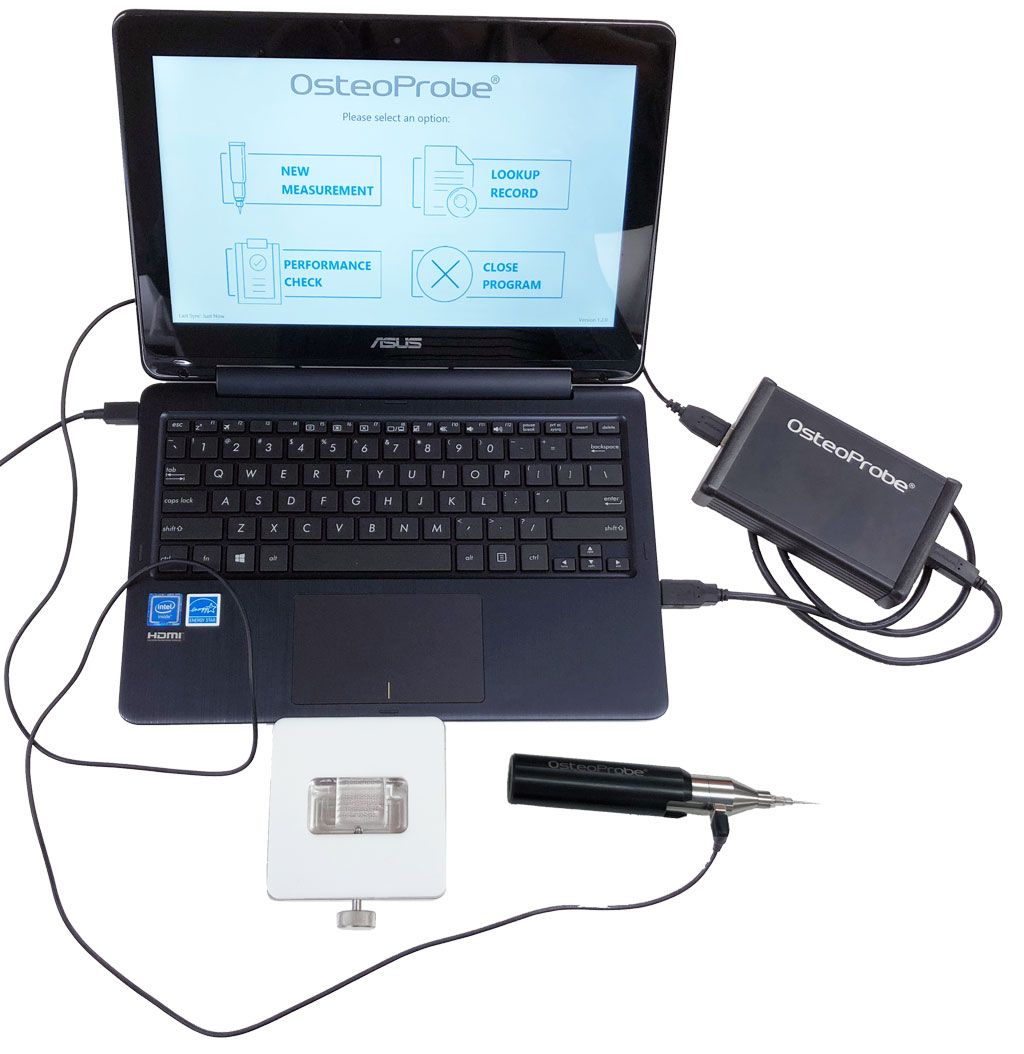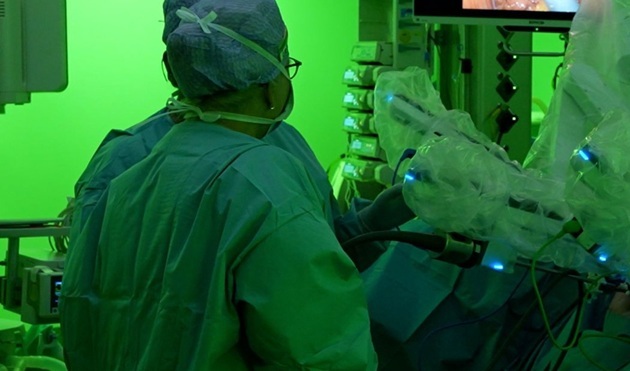Microindentation Device Measures Bone Health
|
By HospiMedica International staff writers Posted on 14 Dec 2021 |

Image: The OsteoProbe handheld bone measurement tool (Photo courtesy of Active Life Scientific)
A novel testing tool physically interacts with bone tissue at the microscopic level, quantifying bone health using a measurable score.
The Active Life Scientific (ALSI; Santa Barbara, CA, USA) OsteoProbe is a handheld tool that uses reference point indentation (RPI) technology in order to investigate bone’s ability to resist puncture. The output is the bone material strength index (BMSi), the ratio between the indentation distance in bone versus a polymathylmethacrylate (PMMA) reference. The BMSi score represents bone properties that resist the separation of mineralized collagen fibrils. Patient bone scores fall between 45 (low) to 105 (high).
“There's a difference between how much bone you have, or density, and how good your bone tissue is. Most patients who suffer a fracture due to fragile bones do not have osteoporotic bone density,” said Professor Paul Hansma, PhD, who invented the technology behind the OsteoProbe. “The Bone Score test quantifies how bone tissue resists a physical challenge, on a safe, microscopic level, and provides previously unavailable data for physicians to consider when investigating the quality of a patient's bone.”
“It's been decades since a new measurement method was introduced to the field of osteoporosis, as DEXA and ultrasound technologies have been widely used since the 1990s. New clinical tools are desperately needed to understand the health of our bones,” said Peter Burks, CEO of ALSI. “Many diseases have a library of measurement tools available, but bone health management remains mostly limited to radiation-based imaging technologies. Physical interaction with bone tissue unlocks a previously unavailable data stream for physicians to consider when evaluating their patients.”
RPI testing is based on the Mohs scale of mineral hardness, in which materials are ranked according to what they can scratch and are, in turn, scratched by. During the course of indentation, a record of the depth of penetration is made, and then the area of the indent is determined using the known geometry of the indentation tip. These values can be plotted to create a load-displacement curve, which can be used to extract more sophisticated mechanical properties of the material.
Related Links:
Active Life Scientific
The Active Life Scientific (ALSI; Santa Barbara, CA, USA) OsteoProbe is a handheld tool that uses reference point indentation (RPI) technology in order to investigate bone’s ability to resist puncture. The output is the bone material strength index (BMSi), the ratio between the indentation distance in bone versus a polymathylmethacrylate (PMMA) reference. The BMSi score represents bone properties that resist the separation of mineralized collagen fibrils. Patient bone scores fall between 45 (low) to 105 (high).
“There's a difference between how much bone you have, or density, and how good your bone tissue is. Most patients who suffer a fracture due to fragile bones do not have osteoporotic bone density,” said Professor Paul Hansma, PhD, who invented the technology behind the OsteoProbe. “The Bone Score test quantifies how bone tissue resists a physical challenge, on a safe, microscopic level, and provides previously unavailable data for physicians to consider when investigating the quality of a patient's bone.”
“It's been decades since a new measurement method was introduced to the field of osteoporosis, as DEXA and ultrasound technologies have been widely used since the 1990s. New clinical tools are desperately needed to understand the health of our bones,” said Peter Burks, CEO of ALSI. “Many diseases have a library of measurement tools available, but bone health management remains mostly limited to radiation-based imaging technologies. Physical interaction with bone tissue unlocks a previously unavailable data stream for physicians to consider when evaluating their patients.”
RPI testing is based on the Mohs scale of mineral hardness, in which materials are ranked according to what they can scratch and are, in turn, scratched by. During the course of indentation, a record of the depth of penetration is made, and then the area of the indent is determined using the known geometry of the indentation tip. These values can be plotted to create a load-displacement curve, which can be used to extract more sophisticated mechanical properties of the material.
Related Links:
Active Life Scientific
Latest Critical Care News
- Ventricular Assist Device Offers Long-Term Use in Children Waiting for Donor Heart
- Precision Approach Improves Immunotherapy Effectiveness for ICU Patients with Sepsis
- Soft Robots Could Donate Their Heart to Humans
- Bioadhesive Strategy Prevents Fibrosis Around Device Implants on Peripheral Nerves
- Miniature Non-Invasive Robotic Catheters to Improve Infertility Treatments
- Stick-On Patch Monitors Baby's Movements In Utero
- EEG-Based AI Technology Accurately Diagnoses Alzheimer’s and Dementia
- Robot Lymphatic System Paves Way for Self-Powered Wearables and Machines
- Focused Ultrasound Technique Successfully Treats Pediatric Brain Cancer
- Nasal Drops Fight Brain Tumors Noninvasively
- AI Helps Optimize Therapy Selection and Dosing for Septic Shock
- Glowing Bacteria ‘Pills’ for Detecting Gut Diseases Could Eliminate Colonoscopies
- Skin-Permeable Polymer Patch Delivers Insulin Non-Invasively Through Skin
- Nanogel Technology Almost 100% Effective in Destroying Drug-Resistant Bacteria Within Hours
- Wearable Ultrasound Sensor Delivers Noninvasive Treatment Without Surgery
- Gel-Free ECG System to Transform Heart Health Diagnosis
Channels
Surgical Techniques
view channel
Minimally Invasive Surgery Proven Safe and Effective for Complex ‘Whipple’ Procedure
Tumors of the pancreatic head often require a highly complex operation known as pancreatoduodenectomy or the Whipple procedure. This surgery involves removing multiple structures and creating several internal... Read more
Catheter-Based Procedures Offer Less Invasive Option for Treatment of Valvular Disease
Valvular heart disease, caused by tight or leaky valves between heart chambers, affects up to 10% of older adults and leads to more than 120,000 deaths globally each year. Traditional open-heart surgery... Read morePatient Care
view channel
Revolutionary Automatic IV-Line Flushing Device to Enhance Infusion Care
More than 80% of in-hospital patients receive intravenous (IV) therapy. Every dose of IV medicine delivered in a small volume (<250 mL) infusion bag should be followed by subsequent flushing to ensure... Read more
VR Training Tool Combats Contamination of Portable Medical Equipment
Healthcare-associated infections (HAIs) impact one in every 31 patients, cause nearly 100,000 deaths each year, and cost USD 28.4 billion in direct medical expenses. Notably, up to 75% of these infections... Read more
Portable Biosensor Platform to Reduce Hospital-Acquired Infections
Approximately 4 million patients in the European Union acquire healthcare-associated infections (HAIs) or nosocomial infections each year, with around 37,000 deaths directly resulting from these infections,... Read moreFirst-Of-Its-Kind Portable Germicidal Light Technology Disinfects High-Touch Clinical Surfaces in Seconds
Reducing healthcare-acquired infections (HAIs) remains a pressing issue within global healthcare systems. In the United States alone, 1.7 million patients contract HAIs annually, leading to approximately... Read moreHealth IT
view channel
EMR-Based Tool Predicts Graft Failure After Kidney Transplant
Kidney transplantation offers patients with end-stage kidney disease longer survival and better quality of life than dialysis, yet graft failure remains a major challenge. Although a successful transplant... Read more
Printable Molecule-Selective Nanoparticles Enable Mass Production of Wearable Biosensors
The future of medicine is likely to focus on the personalization of healthcare—understanding exactly what an individual requires and delivering the appropriate combination of nutrients, metabolites, and... Read moreBusiness
view channel
Philips and Masimo Partner to Advance Patient Monitoring Measurement Technologies
Royal Philips (Amsterdam, Netherlands) and Masimo (Irvine, California, USA) have renewed their multi-year strategic collaboration, combining Philips’ expertise in patient monitoring with Masimo’s noninvasive... Read more
B. Braun Acquires Digital Microsurgery Company True Digital Surgery
The high-end microsurgery market in neurosurgery, spine, and ENT is undergoing a significant transformation. Traditional analog microscopes are giving way to digital exoscopes, which provide improved visualization,... Read more
CMEF 2025 to Promote Holistic and High-Quality Development of Medical and Health Industry
The 92nd China International Medical Equipment Fair (CMEF 2025) Autumn Exhibition is scheduled to be held from September 26 to 29 at the China Import and Export Fair Complex (Canton Fair Complex) in Guangzhou.... Read more












